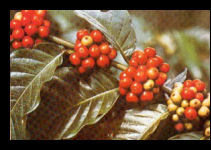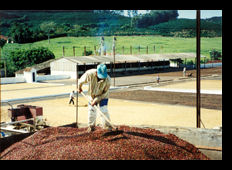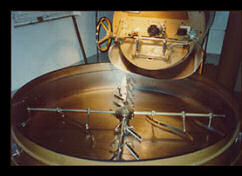The coffee is very different from what we know, or small-grained dark or even already milled. It's a red seed that comes from an evergreen tree that can reach 10 m in height,  of the family Rubiaceae (Abyssinia). of the family Rubiaceae (Abyssinia).
Lives between 800 and 2,000 m high in moist soil at temperatures between 15 and 25 ° C.
Among the approximately forty different species, Coffea arabica is the most widely cultivated: it offers a coffee sweeter and less creamy, unlike the robust from which produces a stronger coffee with about twice caffeine.
It takes at least three years before the plant gets the first fruits of coffee and a single plant, once it reaches full maturity, can provide up to 2,000 berries a year from which we can obtain about a pound of coffee.

The berry contains two kernels inside which is a seed (coffee bean).
Once harvested, the seed is released from the cuticle that surrounds, seasoned and then roasted.
Picked the fruit is passed to the first treatment, which may be dry or wet. Today, the wet, provides a further selection of fruits and a greater homogeneity of the grains. After treatment in humid, the coffee is ready for roasting.
Roasting is a process during which the coffee beans are subjected to a temperature of 200-220 °, being constantly agitated for the time required.
There are different types of roasting, depending on the tastes and habits of consumers,  from the "light roast" the American way, to the Italian "full roast". from the "light roast" the American way, to the Italian "full roast".
All this today involves the use of increasingly sophisticated equipment, in which the grains enter only after having been selected by optical sorting.
The degree and time of roasting are established before on samples of coffee with the help of special colorimeter. Is this delicate phase that differentiates the various types of coffee, both for settings for roasting mixtures taken.
In order to get the flavor you want, was founded the Torrefazione Venturo, allowing Massimo to put his hand in first person, by dosing with almost maniacal attention these very sensitive parameters and dosages until get the flavors and fragrances as wanted.
During roasting the components present in the coffee undergo chemical changes, such as the color change is related to the caramelization of sugars, the carbonization of cellulose and formation of volatile compounds, which is due to the unique aroma of coffee toasted.
The total loss of weight is around 18-20% and is due primarily to remove water while the volume increases by 30-50% and therefore, for this, specific weight will be greatly diminished.
The highest quality aromatic has, of course, with the coffee ground just before use.
To recognize a good espresso just taking a little attention to the examination of the "cup": the cream should have a nice brown color, being particularly dense, so that the layer of sugar to go down slowly, and regroup after the cream have turned sugar.
You can learn to recognize the quality of coffee you have served or that you have prepared yourself by following this handy
Native to tropical Africa, between the thirteenth and fourteenth century. the drink spread throughout the Islamic East. The coffee arrived in Venice (1615) with Turkish ships with Clement VIII and already we have the first request to ban the drink of the devil. In 1637 in Oxford opened the first Coffee House. From the eighteenth century, Dutch in Java and the French Caribbean began in the cultivation, giving birth to the coffee industry. The country with the highest coffee consumption per capita is Finland (13 kg per year, in Italy 4.5 kg).
Currently, most world's coffee production occurs in Brazil. |